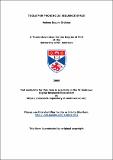Tools for probing 2A sequence space
Abstract
Foot-and-mouth disease virus (FMDV) 2A is an oligopeptide composed of
only 18 amino acids that can mediate a co-translational cleavage at its own C-
terminus. It has been observed that 2A sequences do not show cleavage activity
within bacterial organisms. Why 2A lacks activity in a prokaryotic organism such as
E.coli is unclear. A series of plasmids designed to provide a phenotypic screen for
2A-mediated cleavage (in prokaryotes) were developed. Even though no active 2A
sequences were found in bacteria, this system can easily be adapted to eukaryotic cells
and will also be very useful in mutagenic studies on 2A sequences. Furthermore,
2A[subscript(FMDV)] has been used in the construction of a reporter of stress in the cell. This may
allow us to open a new approach in the use of 2A oligopeptide, which had already
been widely used to co-express genes of interest with reporter proteins, in
biotechnology and gene therapy.
Theiler’s murine encephalomyelitis cardiovirus (TMEV) 2A has the same role as
in FMDV but is 150 aa in length instead of the 18 aa in FMDV. It also presents the
same C-terminal motif but what is the function of the remaining ~85% of the
cardiovirus 2A sequence remains a mystery. To this end we have produced antibodies
against TMEV-2A, to study the role of 2A[subscript(TMEV)] within the cell.
Database searches probing for 2A’s C-terminal conserved motif (-
DxExNPGP-) has identified many 2A-like sequences, not only within picornaviruses
but also in trypanosomes, insect and cellular genes. These remarkable findings
indicate that the control of protein synthesis by 2A is not solely confined to the
Picornaviridae. Bioinformatics analyses of all the known 2A-like sequences,
comparing all the different upstream sequences, show a clear pattern on the
organization of residues in the upstream region.
The discovery of this 2A oligopeptide has led to a breakthrough in protein co-
expression technology. It has been used as a highly effective new tool for the co-
expression of multiple proteins from a single ORF in plant biotechnology and also
gene therapy applications. Although we have gained substantial insights into the
general features and biological significance of this process, a great deal still needs to
be uncovered about the structural and mechanistic details of this unique mechanism of
action.
Type
Thesis, PhD Doctor of Philosophy
Collections
Items in the St Andrews Research Repository are protected by copyright, with all rights reserved, unless otherwise indicated.

